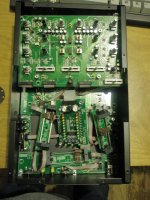What are the benefits of a high-end phono pre-amp vs. my phono DJ mixer. 100% of my recording is vinyl for sampling and production. I'm aiming for high-end audio representation, less noise more music!
By the way, I've noticed this is not your typical DJ/Producer forum so don't yell at me yet!
Current set-up:
Technics SL-1200MK2 x2
Shure M44-7 stylus/carts x2
Rane TTM 56 DJ mixer
DigiDesign 002 Rack
By the way, I've noticed this is not your typical DJ/Producer forum so don't yell at me yet!
Current set-up:
Technics SL-1200MK2 x2
Shure M44-7 stylus/carts x2
Rane TTM 56 DJ mixer
DigiDesign 002 Rack
Well, your TT is top notch, no doubt. The Shure M44-7 cartridge is not what your average audio nerd would use, but then again your average audio nerd does not do any scratching. I see it puts out a max of 9.5mV, which is insanely high compared to regular MM cartridges. But this simply means that your phono preamp will need less gain to get the signal to line level.
If I understand correctly you are simply looking for a different phono preamplifier, right? You'd need two stereo channels which would then be fed into the mixer as a regular line level signal.
What can you expect from a diy phono preamp? First of all you can easily match the cart's impedance (47k // 250p), and even play with it since the cables have an influence on the impedance matching.
Overall I would expect that you get a lot less noise since you can build a super silent regulated powersupply for the circuit, and a lot less distortion since you can match components to make the preamp follow the RIAA equalization precisely. Depending on how your current phono pre is built you can expect a better channel separation as well.
There are basically three choices you have to make first: Tube, opamp or discrete? A circuit with opamps is probably the easiest to build and also to tweak or upgrade, since you can swap opamps in and out of the circuit and give them a listen. Discrete is more work, possibly requires more components and more matching of components, but will yield very good results. Tubes are awesome, expensive, fragile, and many believe phono pres is where they still have their rightful place.
What do you need to build a diy phono pre? Opamp and some discrete circuits can be powered by batteries, either multiple 1.5V cells, 9V blocks or in some cases even car batteries. Bulky, maybe expensive but super silent supply. A real PSU requires that you feel comfortable working with line voltages. With discrete components you can build really nice shunt regulators that are on par with batteries. Tubes usually require very high DC voltages (300V plus).
No matter if you choose active or passive RIAA equalization, you will need to measure and match components, especially capacitors.
If I understand correctly you are simply looking for a different phono preamplifier, right? You'd need two stereo channels which would then be fed into the mixer as a regular line level signal.
What can you expect from a diy phono preamp? First of all you can easily match the cart's impedance (47k // 250p), and even play with it since the cables have an influence on the impedance matching.
Overall I would expect that you get a lot less noise since you can build a super silent regulated powersupply for the circuit, and a lot less distortion since you can match components to make the preamp follow the RIAA equalization precisely. Depending on how your current phono pre is built you can expect a better channel separation as well.
There are basically three choices you have to make first: Tube, opamp or discrete? A circuit with opamps is probably the easiest to build and also to tweak or upgrade, since you can swap opamps in and out of the circuit and give them a listen. Discrete is more work, possibly requires more components and more matching of components, but will yield very good results. Tubes are awesome, expensive, fragile, and many believe phono pres is where they still have their rightful place.
What do you need to build a diy phono pre? Opamp and some discrete circuits can be powered by batteries, either multiple 1.5V cells, 9V blocks or in some cases even car batteries. Bulky, maybe expensive but super silent supply. A real PSU requires that you feel comfortable working with line voltages. With discrete components you can build really nice shunt regulators that are on par with batteries. Tubes usually require very high DC voltages (300V plus).
No matter if you choose active or passive RIAA equalization, you will need to measure and match components, especially capacitors.
- Status
- Not open for further replies.
